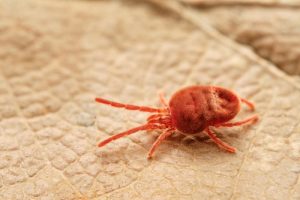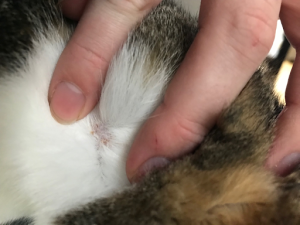Harvest mites are tiny bright orange mites, very like spiders and ticks. They’re a common cause of itchy feet and ears for cats in the autumn. Any cat who walks in damp grass or woodland can pick up harvest mites on their feet, legs and head.
Harvest mites are also called berry bugs, Trombicula, or chiggers. The immature mites attach to your cat’s skin to feed, and their bites are extremely itchy. Cats who are very sensitive will lick, rub and scratch so intensely that they develop more serious skin problems. There aren’t any licensed medicines guaranteed to prevent or kill harvest mites. But regular treatment with a flea spray containing fipronil will help to prevent or treat infestations.

Overview
What are harvest mites in cats?
Harvest mites are tiny orange-red insects barely visible to the naked eye (which means only if you have good eyesight and are under 40!). Harvest mites don’t burrow under the skin. They release a chemical with their saliva when they feed, and it’s this chemical that’s very irritating.
- Adult harvest mites live in woodland, fields of long grass or even gardens.
- Harvest mite larvae climb up the grass and latch onto your cat as they brush past or walk over.
- Mites often clump together, and they’re attracted to your cat’s body heat.
- Mites feed on the skin for 2-3 days to mature and grow
- The problem months are from July to late October
- Bites may appear as a pinprick rash. But they’re so itchy that intense licking or scratching will turn the whole area very red and inflamed before you find out what’s going on
Symptoms
Symptoms of harvest mites in cats
The main symptoms of harvest mites in cats will be itchy, inflamed feet and around ears in late summer and autumn:
- Licking, rubbing, biting paws.
- Red sore skin between toes and pads, around ears and on tummy
- Tail and legs often affected as well
- Saliva-stained hair caused by licking
- Scratching and rubbing behind the ears: Henry’s pocket is a small pouch of skin at the base of your cat’s ear and a favourite hide-out for mites
- Mites are sometimes visible as tiny orange flecks or orange clumps if there are lots of them
Risk
Cats at higher risk of getting harvest mites
Any cats who explore or hunt on damp ground in the woods or on rough grassland can pick up mites.
But some factors will increase risk.
Location and lifestyle:
- Mites are more common in regions with chalky soil than clay.
- Cat with outdoor access to cornfields, scrubby woodland, and grassland
Hair coat and size
- Mites are harder to find on longer-haired cats
- Sparsely-haired skin is easier for mites to feed on
Other illnesses:
- Cats with sensitive skin prone to allergies or inflammation are more likely to be very sensitive to bites. So they’ll also be prone to more serious skin irritation and self-trauma when mites are around.
Complications of harvest mites on cats
- Bacterial skin infections: self-trauma and bites themselves may introduce infection
- Sepsis: Life threatening blood infection resulting from untreated or uncontrolled skin infection
Risks to other family members
- Harvest mites won’t spread between pets, but other cats who go outside will be at similar risk
- Harvest mites also bite humans: Itchy, red rash with raised bumps like tiny, hard pimples. Usually appears on ankles, legs, arms or tummy. Contact your GP if you have these symptoms when your cat has harvest mites.
Diagnosis
How do vets diagnose harvest mites in cats
- Seeing harvest mites on your cat’s itchy feet or ears
- Examining samples from skin under a microscope

Vet treatment
What’s the treatment for harvest mites in cats
Harvest mites are annoyingly hard to get rid of.
- Killing mites: using certain types of flea and parasite treatment, especially fipronil spray
Where necessary:
- Trimming/shaving affected areas to make cleaning and treatment easier
- Treating the itch: steroid injection and/or creams
- Treating skin infection: antibiotic creams, ointments, injections or tablets (or a combination of these)
- Using a buster collar or dressing to prevent further self-trauma
Home treatment
Home care for harvest mites in cats
If you notice your cat suddenly starts chewing their feet or scratching their head and ears between late summer and autumn:
- Check for the orange mites between and under your cat’s toes, or on their head
- Bathe red or sore skin with warm salt water (1 teaspoon salt to 500 ml of boiled, cooled water)
- Use a soothing antibacterial product to treat red, sore skin
- Try to prevent self-trauma with a cone collar
- Keep your cat indoors when harvest mites are a problem
- If letting your cat outdoors, try to limit this to early morning and after dusk, when mites are less active.
- Give any medicines your vet prescribes according to the instructions and complete the course.
Prevention
Tips for preventing harvest mites in cats
Regular preventive treatment
- No treatments are specifically licensed to kill harvest mites. But applying regular anti-flea treatment will reduce risk.
- Use a fipronil-based flea spray under your cat’s legs, chest and tummy and around ears during the harvest mite season
Reducing exposure
Harvest mites are most active during the warmest, driest parts of the day. So changing daily routines can help:
- Keep sensitive cats indoors during the harvest mite season.
- Outdoor access early in the morning and after dusk is best
Constant vigilance
- Parting hairs to check for pin-head orange flecks or clumps as soon as licking or chewing starts
When to worry
When to worry about harvest mites in cats
Seek prompt help from a vet in practice if your cat:
- Is collapsed
- Develops symptoms of sepsis: vomiting, fever, cold paws, breathing difficulty
Call a vet if your cat:
- Becomes distressed with the itch and can’t settle
- Skin looks broken, red and infected from self-trauma
- Is showing signs of illness:
- Eating less
- Being very tired
- Being sick or having diarrhoea
- Developing a high temperature (check for hot ears and tummy)
Joii can help with:
- Recognising and treating harvest mites
- Choosing the best preventive treatments for your cat’s age, breed and lifestyle
- Treating itchy irritated skin








